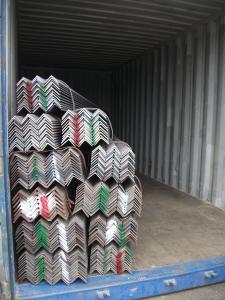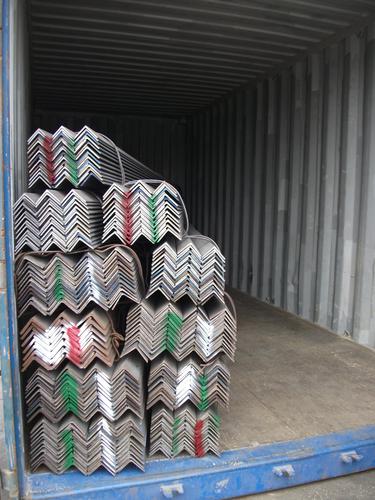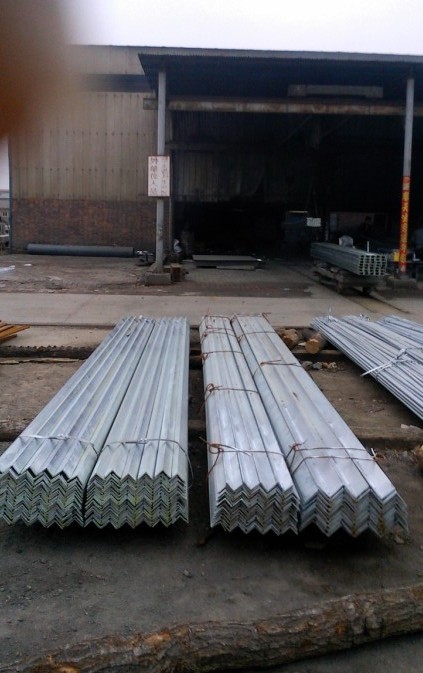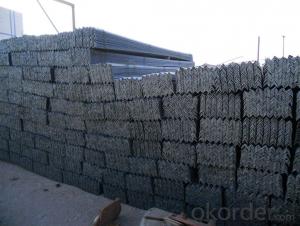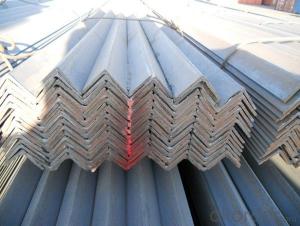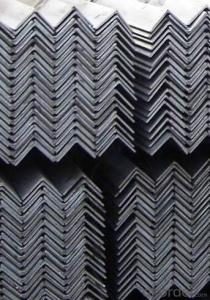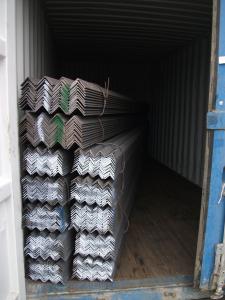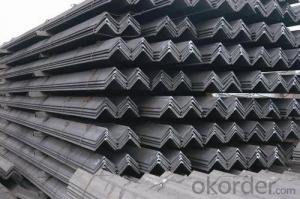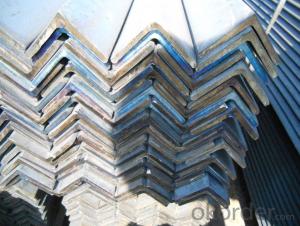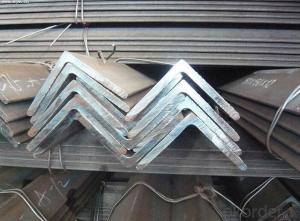Equal Steel Angle Bar
- Loading Port:
- China Main Port
- Payment Terms:
- TT OR LC
- Min Order Qty:
- -
- Supply Capability:
- -
OKorder Service Pledge
OKorder Financial Service
You Might Also Like
Specifications of Angle Steel
1. Invoicing on theoretical weight or actual weight as customer request.
2. Length: 6m, 9m, 12m.
3. Sizes:
| Size(mm) | Mass(Kg/m) | Size(mm) | Mass(Kg/m) |
| 40*40*3 | 1.852 | 45*45*4 | 2.736 |
| 40*40*4 | 2.422 | 45*45*5 | 3.369 |
| 40*40*5 | 2.976 | | |
Payment terms:
1).100% irrevocable L/C at sight.
2).30% T/T prepaid and the balance against the copy of B/L.
3).30% T/T prepaid and the balance against L/C.
Material details:
Alloy No | Grade | Element (%) | | ||||
C | Mn | S | P | Si | | ||
| | |||||||
|
|
|
|
|
|
| |
Q235 | B | 0.12—0.20 | 0.3—0.7 | ≤0.045 | ≤0.045 | ≤0.3 | |
|
|
|
|
|
|
| |
Alloy No | Grade | Yielding strength point( Mpa) | | ||||
Thickness (mm) | | ||||||
≤16 | >16--40 | >40--60 | >60--100 | | |||
≥ | | ||||||
|
|
|
|
|
| | |
Q235 | B | 235 | 225 | 215 | 205 | | |
Alloy No | Grade | Tensile strength (Mpa) | Elongation after fracture (%) | | |||
Thickness (mm) | | ||||||
| ≤16 | >16--40 | >40--60 | >60--100 | | ||
≥ | | ||||||
|
|
|
|
|
|
| |
Q235 | B | 375--500 | 26 | 25 | 24 | 23 | |
*If you would like to get our price, please inform us the size, standard/material and quantity. Thank you very much for your attention.
- Q: Are steel angles suitable for window frames?
- Yes, steel angles are suitable for window frames. Steel angles are often used in construction for their strength and durability, making them an ideal choice for supporting the weight of window frames. They provide excellent structural support, ensuring that the window frames remain stable and secure. Additionally, steel angles are resistant to corrosion, which is particularly advantageous for window frames that are exposed to external elements such as rain and humidity. Furthermore, steel angles can be easily fabricated and customized to meet specific design requirements, making them a versatile option for window frame construction. Overall, steel angles offer numerous benefits that make them a suitable choice for window frames in terms of strength, durability, corrosion resistance, and flexibility.
- Q: What are the common methods of surface finishing for steel angles?
- Steel angles can be surface finished in various ways to achieve specific aesthetic and functional properties. The following methods are commonly used: 1. Paint application: To protect against corrosion and enhance appearance, a protective coat of paint is applied to the steel angle. Different types of paint, like epoxy, acrylic, or powder coatings, are chosen based on specific needs. 2. Galvanization: This method involves immersing the steel angle in molten zinc to create a protective layer on its surface. Galvanization is particularly effective for steel angles exposed to harsh environments or outdoor use. 3. Powder coating: In this process, a dry powder is electrostatically sprayed onto the steel angle and then cured in an oven. The result is a durable finish that resists chipping, fading, and corrosion. Powder coating is preferred when a thicker, more robust finish is desired. 4. Anodizing: Although mainly used for aluminum, anodizing can also be applied to steel angles. It creates an oxide layer on the surface through an electrochemical process, providing increased corrosion resistance and the option to add color. 5. Shot blasting: This surface preparation technique involves bombarding the steel angle with small steel shots at high velocity. Shot blasting removes rust, mill scale, and other impurities, leaving the surface clean and prepared for further finishing processes. 6. Polishing: This technique mechanically smooths and shines the steel angle's surface, achieving a reflective, mirror-like finish or removing imperfections. These methods offer different advantages and are suitable for various applications. The choice of method depends on factors such as desired appearance, environmental conditions, and specific performance requirements.
- Q: How do you bend steel angles?
- To bend steel angles, you will need to follow a few steps. Firstly, make sure you have the right tools and equipment, such as a bending machine or a bending brake. These tools are specifically designed to bend metal angles accurately and efficiently. Next, measure and mark the desired bending point on the steel angle. Use a ruler or a measuring tape to ensure accurate measurements. It is essential to have precise markings to achieve the desired angle. After marking the bending point, secure the steel angle tightly in the bending machine or brake. This will prevent any movement or slippage during the bending process. Now, carefully position the bending machine or brake to align with the marked bending point. Adjust the bending angle according to your requirements. This can usually be done by adjusting the clamps or handles on the machine. Once everything is properly aligned, apply gradual pressure to the bending machine or brake. Start with a low pressure and gradually increase it until the steel angle starts bending. Be patient and avoid applying excessive force, as this can cause the angle to deform or break. Continue applying pressure until the desired angle is achieved. Use a protractor or angle measuring tool to ensure accuracy. If necessary, make any minor adjustments to the angle by repositioning the steel angle in the bending machine or brake. Once the bending process is complete, carefully remove the steel angle from the bending machine or brake. Inspect the angle for any imperfections or deformities. If there are any issues, you may need to repeat the bending process or make adjustments to your technique. It is important to note that bending steel angles can be challenging, especially if you are not experienced or do not have the right tools. If you are unsure about the process, it is recommended to seek professional assistance or consult with a metal fabrication expert who can guide you through the bending process safely and accurately.
- Q: Can steel angles be used in automotive chassis construction?
- Yes, steel angles can be used in automotive chassis construction. Steel angles are commonly used in the construction of automotive chassis due to their structural strength, durability, and cost-effectiveness. They provide excellent support and stability, making them suitable for various chassis components such as frame rails, cross members, and suspension mounting points. Additionally, steel angles can be easily welded or bolted together, allowing for efficient assembly and customization of automotive chassis structures.
- Q: Can steel angles be used for manufacturing bike racks?
- Yes, steel angles can be used for manufacturing bike racks. Steel angles provide strength and durability, making them suitable for supporting the weight of multiple bicycles. Additionally, steel angles can be easily welded or bolted together to create a sturdy frame for the bike rack. The versatility of steel angles allows for customization and design flexibility to accommodate different types and sizes of bicycles. Furthermore, steel angles can withstand outdoor conditions and are resistant to rust and corrosion, ensuring the longevity of the bike rack. Overall, steel angles are a reliable and practical choice for manufacturing bike racks.
- Q: Can steel angles be used as structural supports for bridges?
- Yes, steel angles can be used as structural supports for bridges. Steel angles, also known as angle irons, are commonly used in bridge construction as they provide stability and strength. They can be used as diagonal bracing or as reinforcement for beams and columns, enhancing the structural integrity of the bridge.
- Q: What is the typical corrosion rate of galvanized steel angles?
- The typical corrosion rate of galvanized steel angles can vary depending on several factors such as environmental conditions, exposure to corrosive agents, and the quality of the galvanized coating. However, in general, galvanized steel angles are known for their excellent corrosion resistance properties. The zinc coating on the steel acts as a protective barrier, preventing the underlying steel from coming into contact with corrosive elements such as moisture and oxygen. Under normal atmospheric conditions, galvanized steel angles can have a corrosion rate of approximately 1-5 microns per year. This corrosion rate can be further reduced in less aggressive environments or when additional protective coatings or maintenance practices are employed. Additionally, galvanized steel angles can exhibit even lower corrosion rates in dry or non-corrosive environments. It is important to note that in more severe or highly corrosive environments, the corrosion rate of galvanized steel angles can be accelerated. These environments may include high humidity, exposure to saltwater, acidic or alkaline conditions, or industrial atmospheres with high levels of pollutants. In such cases, it is advisable to consult with corrosion engineers or experts to determine the appropriate corrosion protection measures or alternative materials that may be more suitable for the specific application.
- Q: Can steel angles be used in historical or heritage restoration projects?
- Yes, steel angles can be used in historical or heritage restoration projects. Steel angles are versatile and can be used in a variety of applications, including structural support, reinforcing, and decorative detailing. They can be fabricated to match the original design and materials used in historical structures, ensuring a seamless integration with the existing architecture. Steel angles offer several advantages, such as strength, durability, and resistance to corrosion, which can be particularly beneficial in restoration projects where the goal is to preserve the historical integrity of the structure while improving its structural stability and longevity. Additionally, steel angles can be customized and fabricated to meet specific project requirements, making them suitable for a wide range of restoration applications.
- Q: Can steel angles be used for scaffolding?
- Yes, steel angles can be used for scaffolding. They are commonly used as structural components due to their strength, stability, and durability. Steel angles provide a stable and secure platform for workers to access higher areas during construction or maintenance activities.
- Q: How do steel angles perform in terms of energy efficiency?
- Depending on their design and application, steel angles have the potential to be an energy-efficient choice. The energy efficiency of steel angles relies on various factors, including the type and thickness of the steel, the manufacturing process used, and the installation techniques employed. One factor that influences the energy efficiency of steel angles is their thermal conductivity. Steel, as a conductive material, can rapidly transfer heat, which can be advantageous in certain situations. For example, steel angles can effectively dissipate heat from building components in cooling systems, aiding in maintaining desired temperature levels and reducing energy usage. Moreover, steel angles can be designed to optimize their structural performance, minimizing the need for additional materials or construction methods. This can lead to decreased energy consumption during manufacturing and installation processes. Additionally, steel angles are recyclable, making them an eco-friendly choice. The energy required to recycle steel is significantly lower compared to producing it from raw materials. As a result, this reduces the energy demand and greenhouse gas emissions associated with steel production. However, it is crucial to note that the overall energy efficiency of steel angles also depends on their application and the overall design of the structure. Proper insulation, sealing, and design considerations play a vital role in ensuring optimal energy efficiency. Consulting professionals and engineers is recommended to determine the most efficient use of steel angles in specific projects. In conclusion, steel angles can provide energy-efficient solutions when used appropriately. By considering factors such as thermal conductivity, structural optimization, and recyclability, steel angles can contribute to reducing energy consumption and promoting sustainability in various applications.
Send your message to us
Equal Steel Angle Bar
- Loading Port:
- China Main Port
- Payment Terms:
- TT OR LC
- Min Order Qty:
- -
- Supply Capability:
- -
OKorder Service Pledge
OKorder Financial Service
Similar products
Hot products
Hot Searches
Related keywords
